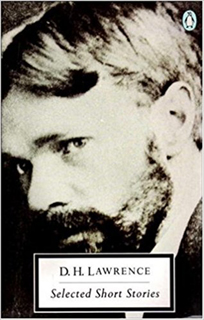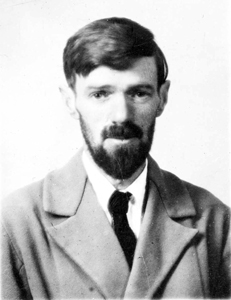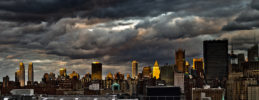
(‘Forrest’ © Andy Rothwell, 2014)
BLURRED BOUNDARIES: D.H. LAWRENCE’S ‘THE PRUSSIAN OFFICER’
by K.S.DEARSLEY
There was a time when I would have been embarrassed to be caught reading a work by D. H. Lawrence. The notoriety of Lady Chatterley’s Lover branded his writing as being full of explicit sex. To read a book by Lawrence on the train would require a plain wrapper if you didn’t want to draw knowing winks and nudges. Now, no one raises an eyebrow if you wave around a copy of Fifty Shades of Grey on your way to work, so when someone gave me a copy of Lawrence’s Selected Short Stories I decided it was time to find out what the fuss was about.
I discovered that in stories such as ‘The Prussian Officer’ any reader expecting to find explicit sex will be disappointed. Lawrence’s writing is far more subtle, working by the power of suggestion, so you could make a case to say that the only sex in the tale is what the reader’s imagination brings to it. Rather than titillating, Lawrence creates a disturbing depiction of a relationship and its power struggle in a way that is all his own.
The story was written in 1913, a time when science, the arts and society were undergoing huge changes. Class and gender roles, Newtonian physics and the nature of reality and perception were all being rethought. The arts were beginning to be influenced by Freud’s notions of the unconscious and by less deterministic theories in physics, such as those of Albert Einstein and Nils Bohr. The traditional style of storytelling was being questioned and Modernist techniques, particularly stream-of-consciousness, were gaining prominence. ‘The Prussian Officer’ neither adheres to the former, nor adopts the latter, yet Lawrence succeeds in breaking down the boundaries of previously accepted binary opposites of male/female, outer/inner, active/passive, civilised/primal and show/tell, demonstrating their fluidity.
The tale concerns the officer of the title and his orderly, the gradual reversal in their relationship, and a violent act which has catastrophic results. On the surface, its construction is traditional. It opens with a description of soldiers on a march through the countryside heading to a forest. The orderly of the officer remembers an incident before leaving that morning. The core of the story, is told in flashback, before returning to the march and the tragedy that follows. The notion of each thing containing its opposite, and therefore representing the ‘both/and’ of quantum physics rather than the ‘either/or’ of the Newtonian paradigm, is shown by the flashback narrated during the march through the countryside; in effect, the past is embedded in the present. However, the narrative swings pendulum-like between the point of view of the captain and the orderly, making the action that unfolds seem inevitable, predetermined.
Instead of traditional linear forms, Lawrence employs rhythms and rhymes to build patterns and create a feeling of symbolism and inevitability: ‘The dark green rye threw off a suffocating heat, the mountains drew gradually nearer and more distinct. While the feet of the soldiers grew hotter…’ Sentences beginning with conjunctions such as ‘and’ or ‘but’, and the use of ‘while’ and ‘on and on’, help the narrative to build with a child-like ‘and then’ style progression. When the action intensifies, Lawrence uses short, chopped up sentences, which echo the jerky, breathless struggle of the characters, stemming the flow of their emotions. The superficial details of life are animated and given agency — ‘thickets of trees threw a moment of shade’, ‘once, when a bottle of wine had gone over and the red gushed out…’ — putting conscious actions on the same level as unconscious ones. Agentless sentences, such as ‘Then the change gradually came’, show both men to be helpless and therefore blameless.
 The characters are mostly referred to by their roles, ‘captain’ and ‘orderly’, rather than their names. The story begins: ‘They had marched…’ ‘They’ could be any nationality or from any period, making them symbols of universal everymen rather than individuals. Superficially, the officer and the orderly are a binary pair: the orderly sees himself as the officer’s ‘shadow’. The captain has ‘stiff hair’, and a ‘brutal mouth’. Lawrence describes him as unliving and fixed. As the orderly’s superior, initially the officer is in control of their relationship. He is the aggressor and actor in their dealings, who enjoys inflicting pain. The orderly is passive and submissive. The officer’s animosity towards the orderly could be jealousy of the younger man’s warmth and naturalness. Both men have expressionless eyes that show no emotion on the surface. In swinging from the point of view of one to the other, Lawrence not only makes them equals but allows the reader to see each through the other’s eyes and notice the similarities. The orderly ‘admired the amazing riding muscles of his [the officer’s] loins’. The officer was ‘infuriated by the free movement of the handsome limbs’ of the orderly. The orderly ‘rubs down’ the officer, in the same way a horse would be rubbed down after exercise, and the orderly is described as having ‘shapely’ hands and the ‘instinctive sureness of movement of an unhampered young animal’, much as the horse is described as ‘slim-legged and beautiful’. Furthermore, both men have dubious relationships with women. The officer occasionally took a mistress, and the orderly has a sweetheart with whom he walks but does not talk.
The characters are mostly referred to by their roles, ‘captain’ and ‘orderly’, rather than their names. The story begins: ‘They had marched…’ ‘They’ could be any nationality or from any period, making them symbols of universal everymen rather than individuals. Superficially, the officer and the orderly are a binary pair: the orderly sees himself as the officer’s ‘shadow’. The captain has ‘stiff hair’, and a ‘brutal mouth’. Lawrence describes him as unliving and fixed. As the orderly’s superior, initially the officer is in control of their relationship. He is the aggressor and actor in their dealings, who enjoys inflicting pain. The orderly is passive and submissive. The officer’s animosity towards the orderly could be jealousy of the younger man’s warmth and naturalness. Both men have expressionless eyes that show no emotion on the surface. In swinging from the point of view of one to the other, Lawrence not only makes them equals but allows the reader to see each through the other’s eyes and notice the similarities. The orderly ‘admired the amazing riding muscles of his [the officer’s] loins’. The officer was ‘infuriated by the free movement of the handsome limbs’ of the orderly. The orderly ‘rubs down’ the officer, in the same way a horse would be rubbed down after exercise, and the orderly is described as having ‘shapely’ hands and the ‘instinctive sureness of movement of an unhampered young animal’, much as the horse is described as ‘slim-legged and beautiful’. Furthermore, both men have dubious relationships with women. The officer occasionally took a mistress, and the orderly has a sweetheart with whom he walks but does not talk.
The way both men refuse to acknowledge to themselves what happens, and how they feel, equates them further. The orderly distances himself from his service: ‘It did not implicate him personally’, and the officer ‘did not choose to be touched into life by his servant’. All it takes is for their eyes to meet to set their relationship on a darker course, which neither man wants but both feel unable to halt. In the orderly’s mind ‘he felt he was connected’. Both prefer emptiness, neutrality, but when their eyes meet the orderly ‘…felt something sink deeper’ and ‘some of his natural completeness in himself was gone’. After this, the officer becomes the passive one, not meeting the orderly’s gaze or crying out when he becomes the actor. The eyes meeting is a more pivotal point than the later violence. It is here that each sees himself in the other, not that Lawrence states as much.
Readers are only told about the physical world – actions and descriptions – but are shown thoughts, feelings and senses. The narrative cannot tell the reader what the thoughts and emotions the characters shy away from are, because the characters have no language to articulate them. This demands that the reader infer them. When the orderly’s ‘thirst seemed to have separated itself from him’, is the ‘thirst’ only for water, or his passion? The narrative is much concerned with the gaze; looking or not looking, which, as a deliberate act, represents conscious thought. The eyes and other body parts, such as the hands and feet, are often the agents of sentences: ‘The hands of the officer twitched and seemed to be full of a mad flame’, so that they appear to act on their own volition and therefore represent the unconscious, or what Lawrence might have termed ‘the primal’ when he later developed his own theory of the unconscious. Unlike Freud, he did not see this as something separate or buried but as the primal force in charge of a person’s automatic systems, such as digestion or growth, effectively making people two beings in one. As Brian Finney puts it in his 1982 introduction to Lawrence’s Selected Short Stories: ‘It is the underlying concern with life’s dual nature which informs the shape of his earlier stories.’ At the same time, Lawrence tells readers about the landscape or physical actions, he allows gaps between or beneath his words to suggest these prelinguistic drives and emotions, which in the end are shown to be more powerful and important than conscious decisions or social conditioning.
The landscape is effectively a third character and it is also binary, juxtaposing ‘the burnished, dark green rye [which] threw off a suffocating heat’ and ‘black pine woods’ with the ‘snowy peaks’ of the distant mountains. Lawrence follows traditional symbolism in these descriptions with their connotations of the mountains’ white snow and distant unattainability with purity, and the fertility and the darkness of the fields and forest equating with wildness and disorder outside society. It is in the forest that the reversal of roles occurs; the orderly allows his primal self to take control and enjoys the violence, while the officer becomes passive. Yet Lawrence also shows both mountains and woodland to be primal. The trunks of trees ‘stripped and glistening, lay stretched like naked, brown-skinned bodies’, thus they are passive and powerless. The mountains ‘rose sheer out of the land, and stood fold behind fold’ and ‘slits of soft snow, in the pale, bluish peaks’ evoke both the phallic and the feminine. The march from the hot and sweaty lowlands to reach the peaks becomes orgasmic.
 The traditional imagery and connotations continue with descriptions such as ‘red gushed out on the tablecloth’ when the wine is knocked over, echoing the red and white of passion and purity, blood and semen, sex and death. The symbolism of the orderly’s thumb pinned with a pencil is relatively overt, especially as the officer ‘wanted to get hold of it and…’, and Lawrence also nudges readers towards a sexual interpretation with words such as: ‘But the influence of the young soldier’s being had penetrated through the officer’s stiffened discipline’ and ‘sun, drilling down on him’ and ‘…when he thought of the threat of more kicking … his heart went hot and faint, and he panted, remembering the one that had come’. The imagery is reinforced by alliteration, particularly sibilants and combinations of sibilants and liquid consonants: ‘streaks of sweat coming on the silky bay horse’, ‘acid’, ‘pencil’, ‘glistening’, ‘splashed’ – so the sounds become associated with connotations of sex and sensuality throughout the story. Once again, Lawrence creates a duality where what is not overtly written is, however, present beneath.
The traditional imagery and connotations continue with descriptions such as ‘red gushed out on the tablecloth’ when the wine is knocked over, echoing the red and white of passion and purity, blood and semen, sex and death. The symbolism of the orderly’s thumb pinned with a pencil is relatively overt, especially as the officer ‘wanted to get hold of it and…’, and Lawrence also nudges readers towards a sexual interpretation with words such as: ‘But the influence of the young soldier’s being had penetrated through the officer’s stiffened discipline’ and ‘sun, drilling down on him’ and ‘…when he thought of the threat of more kicking … his heart went hot and faint, and he panted, remembering the one that had come’. The imagery is reinforced by alliteration, particularly sibilants and combinations of sibilants and liquid consonants: ‘streaks of sweat coming on the silky bay horse’, ‘acid’, ‘pencil’, ‘glistening’, ‘splashed’ – so the sounds become associated with connotations of sex and sensuality throughout the story. Once again, Lawrence creates a duality where what is not overtly written is, however, present beneath.
There are many sexual connotations in ‘The Prussian Officer’, but it is not only about sex, or whether the conscious or unconscious is in control. It demonstrates that both are always present and are influencing each other. The mixed emotions both men experience form more binary opposites, but are inextricably mixed – pleasure/pain, euphoria/control, pride/shame, freedom/oppression. The halves of each pairing form the ingredients of the ultimate binary opposite: civilised or conscious verses primal or unconscious. Both men recognise the primal in the other one and seek to deny it in themselves. Their actions result from being forced to see that their sense of their own identity is wrong. The real struggle in ‘The Prussian Officer’ is not for a balance of power between a superior and an underling, but between the conscious and the primal. Ultimately, trying to deny or suppress the unconscious or primal leads to disaster.
The mixture of traditional and Modernist writing techniques forces the reader to perform a similar balancing act. Did the captain feel sexual passion for the orderly? Did he envy his instinctive freedom? Or did he merely want to be noticed? Is what we find in the story really there, or is it in us? Some might find the lack of firm answers unsatisfying, but the success of a story can be measured by how many questions it provokes and how many times the reader feels compelled to return to it to pin it down. It is equally difficult to pin down Lawrence’s writing technique. ‘The Prussian Officer’ is neither Modernist nor traditional and it is both. How much of Lawrence’s style was conscious and how much instinctive, probably even the author couldn’t tell. One thing is certain: it’s about much more than sex.
~
 K.S. Dearsley has an MA in Linguistics and Literature, and her fiction and poetry have been published on both sides of the Atlantic. This is her third feature for Thresholds. Find out more at http://www.ksdearsley.com.
K.S. Dearsley has an MA in Linguistics and Literature, and her fiction and poetry have been published on both sides of the Atlantic. This is her third feature for Thresholds. Find out more at http://www.ksdearsley.com.

